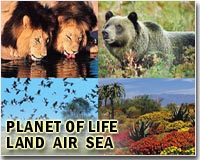| . |  |
. |
Knoxville TN (SPX) Apr 5, 2011 Bats in North America are under a two-pronged attack but they are not the only victim - so is the U.S. economy. Gary McCracken, head of the Department of Ecology and Evolutionary Biology at the University of Tennessee, Knoxville, analyzed the economic impact of the loss of bats in North America in agriculture and found it to be in the $3.7 to $53 billion a year range. McCracken's findings are published in the April edition of Science and can be found online here. McCracken conducted his study with Justin Boyles of the University of Pretoria in South Africa, Paul Cryan of the U.S. Geological Survey and Thomas Kunz of Boston University. Since 2006, more than a million bats have died due to a fungal disease called White-Nose Syndrome (WNS). At the same time, several migratory tree-dwelling species are being killed in unprecedented numbers by wind turbines. This hurts the economy because bats' diet of pest insects reduces the damage the insects cause to crops and decreases the need for pesticides. In fact, the researchers estimate the value of bats to the agricultural industry is roughly $22.9 billion a year, with the extremes ranging as low as $3.7 and $53 billion a year. "These estimates include the reduced costs of pesticide applications that are not needed to suppress the insects consumed by bats. However, they do not include the downstream impacts of pesticides on humans, domestic and wild animals and our environment," said McCracken. "Without bats, crop yields are affected. Pesticide applications go up. Even if our estimates were quartered, they clearly show how bats have enormous potential to influence the economics of agriculture and forestry." According to the researchers, a single colony of 150 big brown bats in Indiana eat nearly 1.3 million insects a year - insects that could potentially be damaging to crops. WNS infects the skin of bats while they hibernate. Some species such as the little brown bat are likely to go extinct in parts of North America. The disease has quickly spread from Canada to Tennessee, Missouri and Oklahoma and actions to slow or stop it have proven unsuccessful. It is unknown how many bats have died due to wind turbines, but the scientists estimate by 2020, wind turbines will have killed 33,000 to 111,000 annually in the Mid-Atlantic Highlands alone. Why migratory tree-dwelling species are drawn to the turbines remains a mystery. Due to the economic and ecological importance, the researchers urge policy-makers to avoid a wait-and-see approach to the issue of widespread declines of bat populations. "Not acting is not an option because the life histories of these flying, nocturnal mammals - characterized by long generation times and low reproductive rates - mean that population recovery is unlikely for decades or even centuries, if at all," said McCracken. According to McCracken, solutions will only be fueled in the next few years by increased awareness of the benefits of insectivorous bats among the public, policymakers and scientists.
Share This Article With Planet Earth
Related Links University of Tennessee at Knoxville Darwin Today At TerraDaily.com
 Thousands cheer capture of revered Vietnam turtle
Thousands cheer capture of revered Vietnam turtleHanoi (AFP) April 3, 2011 Thousands of onlookers cheered in central Hanoi on Sunday when rescuers captured for treatment an endangered and ailing giant turtle revered as a symbol of Vietnam's centuries-old independence struggle. On the first attempt to snare it in polluted Hoan Kiem Lake one month ago the feisty old animal broke free from a net. This time about 50 rescuers took about two hours --- and three nets ... read more |
|
| The content herein, unless otherwise known to be public domain, are Copyright 1995-2010 - SpaceDaily. AFP and UPI Wire Stories are copyright Agence France-Presse and United Press International. ESA Portal Reports are copyright European Space Agency. All NASA sourced material is public domain. Additional copyrights may apply in whole or part to other bona fide parties. Advertising does not imply endorsement,agreement or approval of any opinions, statements or information provided by SpaceDaily on any Web page published or hosted by SpaceDaily. Privacy Statement |